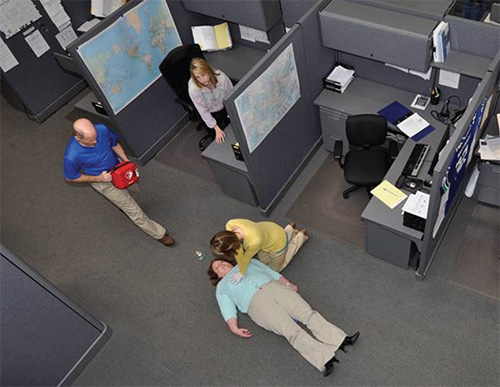AEDs in the workplace
What are some best practices for AED program management in the workplace?

Responding is Steve Barnett, vice president, sales operations, Health & Safety Institute, Eugene, OR.
 According to the American Heart Association, more than 300,000 sudden cardiac arrests (SCA) occur annually in the United States and, according to OSHA, about 10,000 occur at work. Fortunately, companies that implement an automated external defibrillation program and have employees prepared to respond to an SCA increase the chance of survival.
According to the American Heart Association, more than 300,000 sudden cardiac arrests (SCA) occur annually in the United States and, according to OSHA, about 10,000 occur at work. Fortunately, companies that implement an automated external defibrillation program and have employees prepared to respond to an SCA increase the chance of survival.
Here are five keys to maximizing your AED program’s effectiveness and ensuring your device will perform when needed.
1. Championing: Have an internal champion to help promote and educate your workers with these successful elements:
- Informational brochure about your AED program, including what defibrillators are, how they work, etc.
- Annual review of emergency response plan (including AED program)
2. Recordkeeping/device tracking/maintenance: Integrate your defibrillator maintenance schedule into your safety program schedule, including fire alert and suppression systems, personal protective equipment, and other maintained systems. Although most devices have warning signals to indicate when the device is not ready for use, an asset management tracking system can be used to record the expiration dates of your defibrillators’ consumables, such as batteries and pads, and to keep track of your units without the need for a physical presence of an employee.
3. AED placement: OSHA offers a list of optimal places to consider when installing an AED:
- Areas that allow response within three to five minutes
- Areas where people work closely together, such as assembly lines and office buildings
- Areas close to a confined space
- Areas where electric-powered devices are used
- Outdoor worksites where lightning may occur
- Health units where workers may seek treatment for heart attack symptoms
- Company fitness units and cafeterias
- Remote sites, such as off-shore drilling rigs, construction projects and power transmission lines
4. Training: Ensure your employees know how to use your company’s specific AED and how to recognize when the device is in need of service, as well as these critical response elements:
- How to recognize SCA and how to activate your emergency response plan, including location of the AEDs and activation of the emergency medical services system
- How to perform CPR and, if untrained, compression-only CPR
- How to provide care until help arrives
5. SCA drills: Including AEDs in your emergency response drills helps identify weaknesses that could be overlooked. Key drill elements should include:
- Pre-drill preparation, including notifying key personnel and preparing equipment
- Pre-exercise briefing
- Simulated SCA medical exercise, including appropriate response checklists
- Debriefing
- Additional exercises or CPR and AED practice for emergency response team members
Editor's note: This article represents the independent views of the author and should not be construed as a National Safety Council endorsement.
Post a comment to this article
Safety+Health welcomes comments that promote respectful dialogue. Please stay on topic. Comments that contain personal attacks, profanity or abusive language – or those aggressively promoting products or services – will be removed. We reserve the right to determine which comments violate our comment policy. (Anonymous comments are welcome; merely skip the “name” field in the comment box. An email address is required but will not be included with your comment.)

